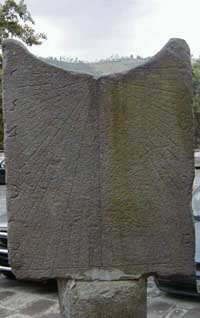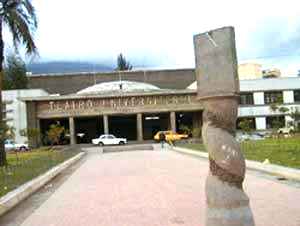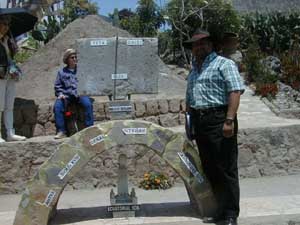 For
a full overview click here
For
a full overview click here  For
a full overview click here For
a full overview click here Ecuador sundial trail |
|---|
| This sundial trail is dedicated to the people of Ecuador Quito is the capital of Ecuador, and has an ancient history going back to well before the Spanish occupation, which totally destroyed the ancient city. Quito lies about 10 miles south of the Equator, so that gnomons parallel to the earths axis are horizontal, which makes for some unusual sundials. This sundial trail starts on the eastern edge of Quito. Start at the Quito Hotel, which is at the top of Av. 12 de Octobre.  Behind it, there is a little ethnographic museum and sales outlet, with
a cafe and a viewpoint (mirador). If you are facing the main door of the
hotel, you walk to your left, and take the first turning down the hill
to your right. The mirador has a wooden statue of Eve wrestling the serpent.
Far down in the gorge below, you will see the church of Guapolo. There
is a footpath straight down the side of the hill to reach the church in
10 minutes of so. Outside the church is a vertical sundial on a pillar,
probably dating from the XVII century when the church was built under
the direction of Fray A Rodriguez. The sundial unfortunately lacks a gnomon,
though there is a channel on the top of the stone which shows clearly
where the horizontal gnomon should be. After this visit, you can find
a bus slightly further down the hill which will take you back to Quito
old town for around 10 US cents.
Behind it, there is a little ethnographic museum and sales outlet, with
a cafe and a viewpoint (mirador). If you are facing the main door of the
hotel, you walk to your left, and take the first turning down the hill
to your right. The mirador has a wooden statue of Eve wrestling the serpent.
Far down in the gorge below, you will see the church of Guapolo. There
is a footpath straight down the side of the hill to reach the church in
10 minutes of so. Outside the church is a vertical sundial on a pillar,
probably dating from the XVII century when the church was built under
the direction of Fray A Rodriguez. The sundial unfortunately lacks a gnomon,
though there is a channel on the top of the stone which shows clearly
where the horizontal gnomon should be. After this visit, you can find
a bus slightly further down the hill which will take you back to Quito
old town for around 10 US cents. The second sundial is outside the main entrance of the Universidad Central de Quito, which is on a roundabout on the avenida America.  This too is a vertical sundial, with gnomons which have been bent out
of alignment. The stone is in quite good condition, and on the south side
has three mottoes. On the top is CREO NESCITUR DOMINET HORA, a quotation
from Matthew XXV. Between the hour lines is I IRA QUI TENSES and the bottom
one is difficult to decipher. On the north side, which is operational
from March 21 to September 21, the top motto is illegible, and the bottom
one reads TENERAS FUERINT NUBILA NULLUS ERO. this side has the identical
motto between the hour lines. There are also hour markings on the two
thin sides of the stone slab, presumably for use at the equinoxes when
the sun is vertically overhead, and will thus not illuminate either of
the main faces. One of these has the date AD 1766. This is a very fine
sundial which would fully merit some careful restoration.
This too is a vertical sundial, with gnomons which have been bent out
of alignment. The stone is in quite good condition, and on the south side
has three mottoes. On the top is CREO NESCITUR DOMINET HORA, a quotation
from Matthew XXV. Between the hour lines is I IRA QUI TENSES and the bottom
one is difficult to decipher. On the north side, which is operational
from March 21 to September 21, the top motto is illegible, and the bottom
one reads TENERAS FUERINT NUBILA NULLUS ERO. this side has the identical
motto between the hour lines. There are also hour markings on the two
thin sides of the stone slab, presumably for use at the equinoxes when
the sun is vertically overhead, and will thus not illuminate either of
the main faces. One of these has the date AD 1766. This is a very fine
sundial which would fully merit some careful restoration.  The third sundial is near the "Mitad del Mundo" monument, which is well
worth a visit. There is a good view from the top of the monument, which
also has an interesting ethnographic museum. The avenue commemorates the
astronomers who measured the length of the Equator from observations here.
There is a very please group of cafes, artisan shops, etc. within the
park site. Just outside it is the Inti Nan museum. Inti Nan is a Quechua
word meaning the "Route of the Sun" (Camino del Sol). the museum was set
up by Fabian Vera, who still runs it. He is very interested in the astronomical
knowledge of the pre-Columbian Indians
The third sundial is near the "Mitad del Mundo" monument, which is well
worth a visit. There is a good view from the top of the monument, which
also has an interesting ethnographic museum. The avenue commemorates the
astronomers who measured the length of the Equator from observations here.
There is a very please group of cafes, artisan shops, etc. within the
park site. Just outside it is the Inti Nan museum. Inti Nan is a Quechua
word meaning the "Route of the Sun" (Camino del Sol). the museum was set
up by Fabian Vera, who still runs it. He is very interested in the astronomical
knowledge of the pre-Columbian Indians |